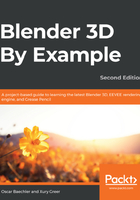
Creating tables with box modeling
Now, we're ready to move on to the modeling stage to create a kitchen table and coffee table with familiar modeling workflows. When we're finished, we'll bring the table and other assets into the kitchen scene via linking, which allows us to assemble a complex scene from assets that come from separate scenes.
The kitchen and coffee tables will use old fashioned box modeling, plus a few modifiers to help. Let's get started by making a new Blender scene and making the tabletop shape:
- Start a new Blender scene and immediately save it as ch05_table.blend.
- Switch to the Top view.
- Add a plane, then set its size to 1 m, as in the following screenshot:

- Tab to Edit Mode.
- Open the context menu by right-clicking and choose Subdivide.
Subdividing has given us an additional edge loop through the vertical and horizontal sections of the plane, which also means there is an additional vertex in the middle of each side. We can use this to spin a rounded section for our tabletop:
- Switch to the Vertex Select mode.
- Select the middle vertex along the right side (this will be the center of the half-circle on this side).
- Open the Snap pie menu (Shift + S) and choose Cursor to Selected.
- Switch to the Edge Select mode.
- Select the following edge with the 3D Cursor.
- Activate the Spin tool from the toolbar.
- While still in the Top view, pull one of the + widgets to rotate edges out from the three-dimensional cursor.
- In the tool's dialog, you can also set precision amounts—use 12 steps and a 180-degree angle, with Auto Merge turned on, as in the following screenshot:

Good, we've got some nice roundness to our table. Now, let's raise it up to the table height and extrude it downward to add some thickness:
- Switch to the Face Select mode.
- Select all the faces.
- Move them up to the table height that we measured earlier with our previz table by pressing G, Z, and .8.
- Extrude the faces downward with E, Z, and -.1 to add thickness to the table.
- Delete the faces on the non-rounded side.
- Add a Mirror modifier.
Good, now we can create a metal border around the table as a separate object:
- Select the face loop around the table's border edge and duplicate it with Shift + D.
- Separate the selection into a new object by pressing P.
- Tab to Object Mode and select the rim object.
- Tab to Edit Mode for the rim object.
- Scale all the faces on the Z-axis slightly to make the rim noticeable.
- Tab back to Object Mode again.
- Add a Solidify modifier to the rim object with a thickness of .1.
Our metal rim would look better with some smooth shading, just like we did for the time machine in the previous chapter:
- Select the rim object, open the context menu with a right-click, and choose Shade smooth.
- Go to the Object Data tab in the Properties panel.
- Activate Auto Smooth under the Normals section.
Great—now, let's make the four table legs. They will be curved wooden planks that taper toward the bottom:
- Create a plane.
- Tab to Edit Mode.
- Move an edge up to the table's height and scale it so that it tapers toward the floor. Insert an edge loop for where it curves direction, move it up for the turning point, and bevel it with Ctrl + B, using the middle of the mouse wheel for extra divisions.
- Add a Mirror modifier and activate both the X and Y axes.
- Add a Solidify modifier with a 0.03 m thickness.
- Rotate all the faces by 45° on the Z axis and place it to form the four corners of the table, as in the following screenshot:

Now, that's a good-looking table! Let's make a coffee table to go along with it using a similar workflow:
- Start with a plane, then in Edit Mode, move it up to 0.5m, then extrude down 0.05m for the tabletop. Duplicate and scale these in Edit Mode for the coffee table's body.
- Bevel the corner edges of the tabletop with Ctrl + B.
- Inset the left and right faces for the drawers with the I hotkey and scale them to fit.
- Finish them by extruding inward, duplicating the faces, and extruding them outward.
- Create a new cube, resize it to a starting leg, and add a mirror modifier for the four legs.
- Select the outer face of your drawer, set the 3D Cursor to selected with Shift + S, and add a cylinder. Taper the cylinder inward and outward for the drawer handles.
- For added visual interest, turn a new plane into a quick chessboard on top of the coffee table.
Our example coffee table turned out like this:

Nearly every Blender project will have something that is made with these polygonal modeling workflows, such as window sills, picture frames, and other furniture.
Now that we've made a couple of tables, let's link them back to our kitchen scene.